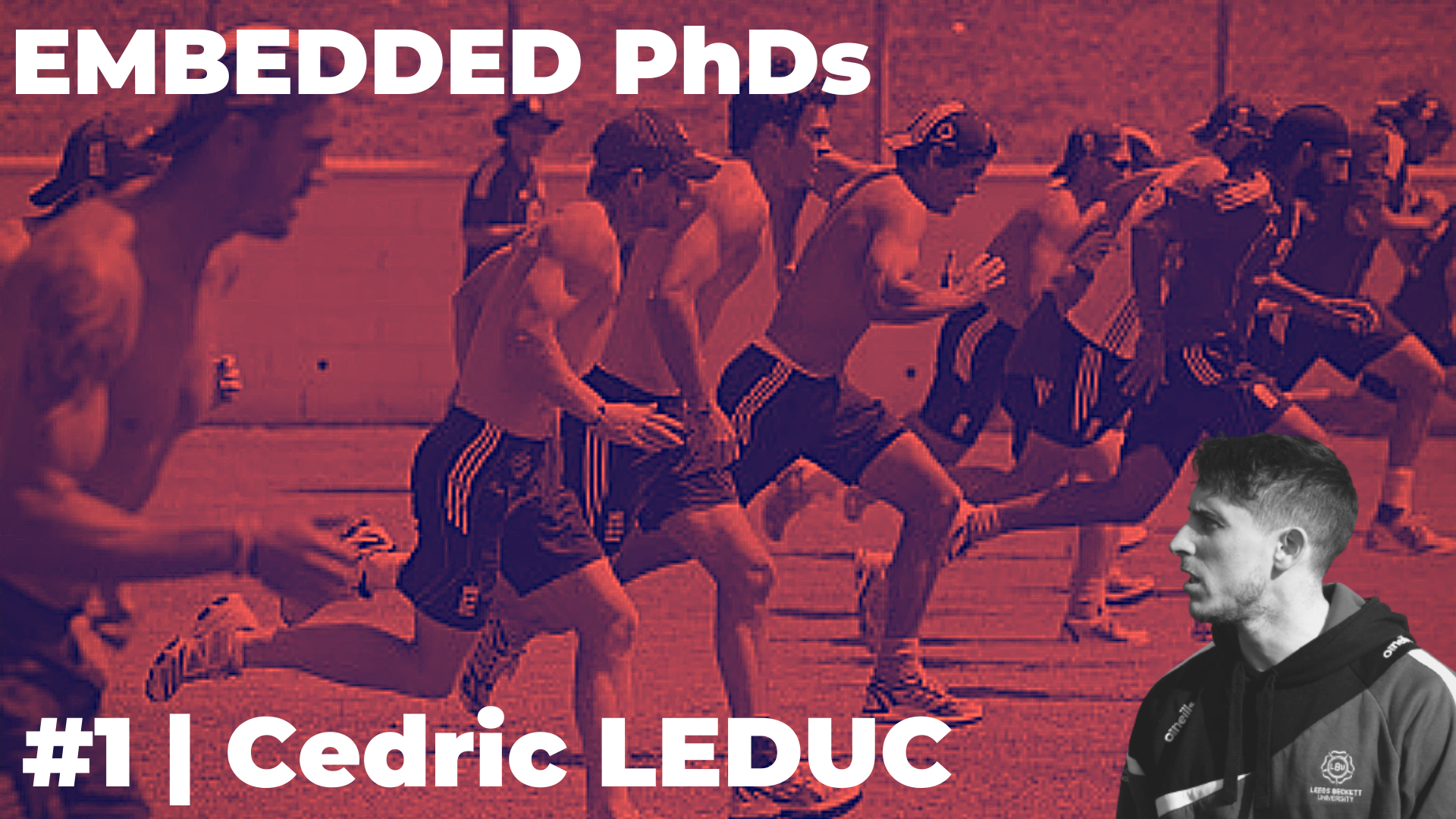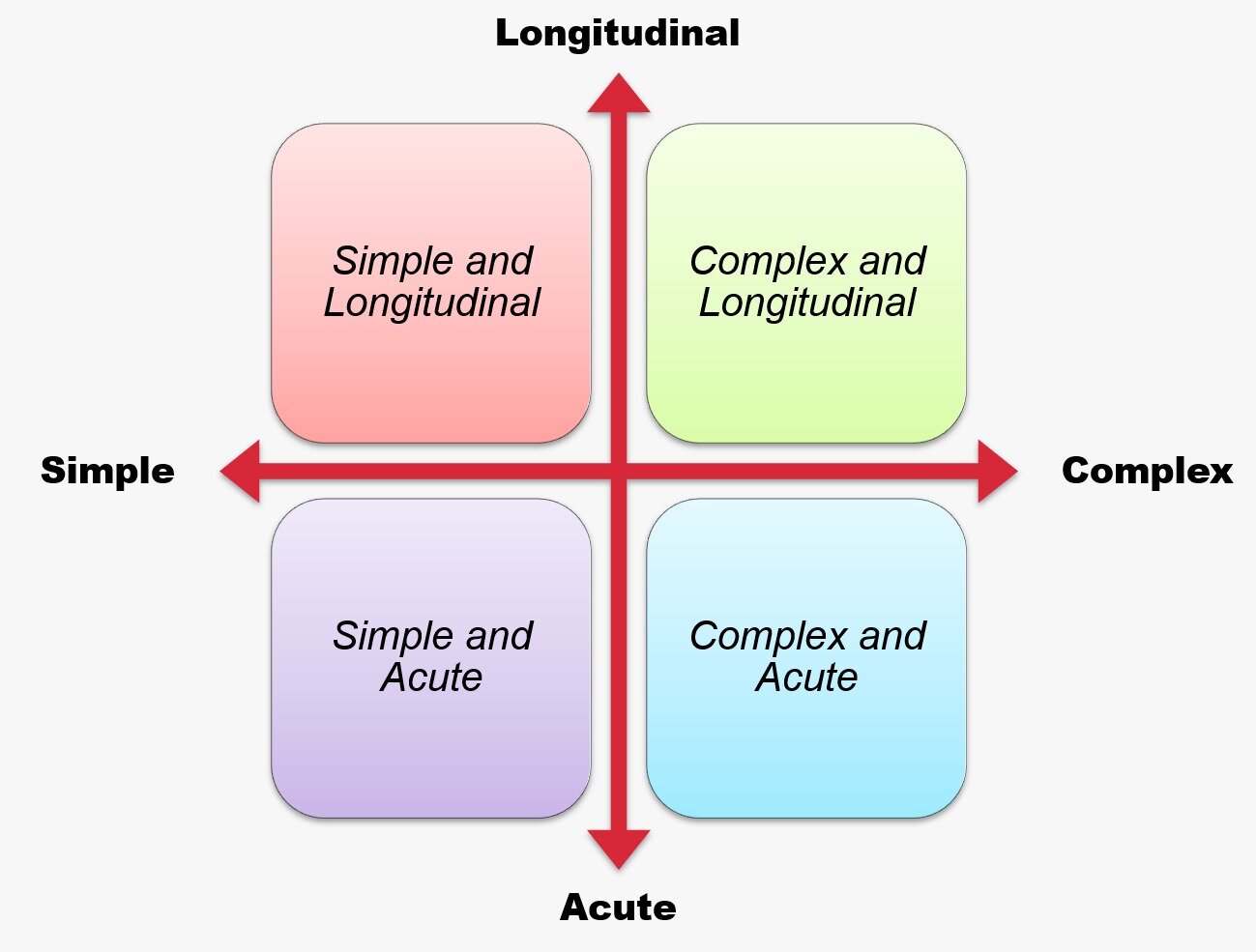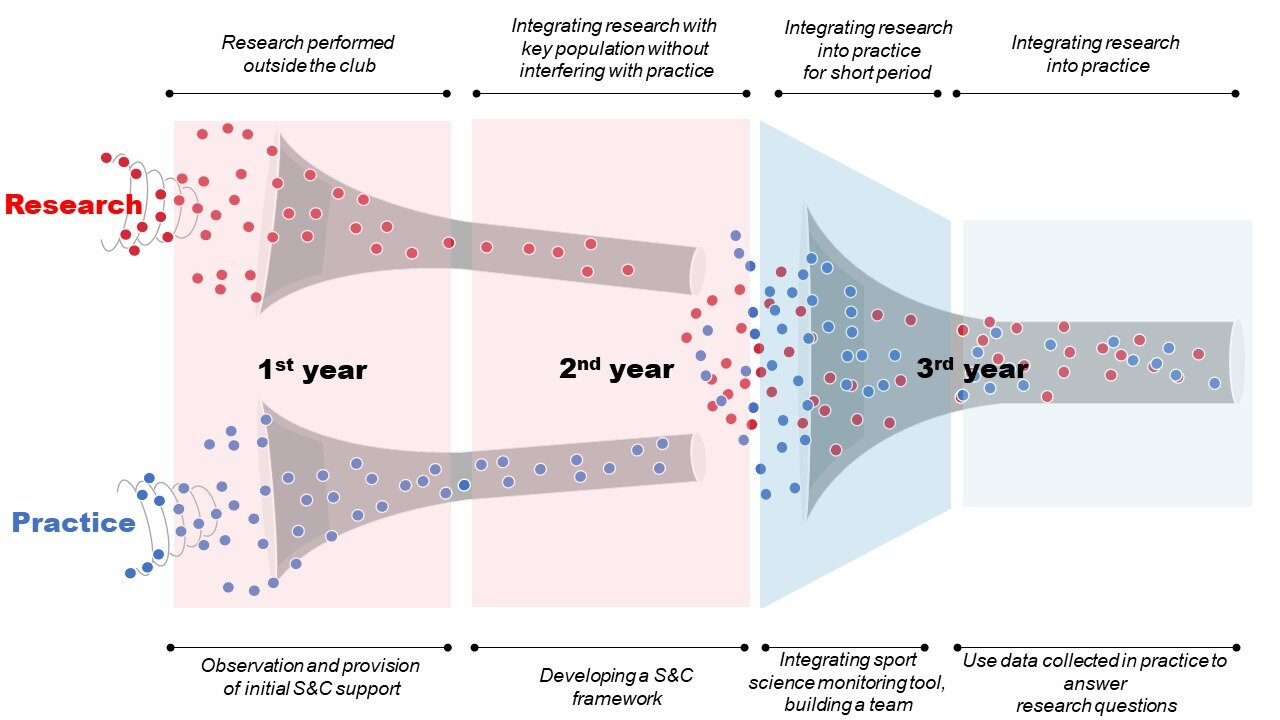Insights from an Embedded PhD: #1 - Cedric Leduc
Who are you ?
I'm Cédric Leduc and I have just completed my PhD at Leeds Beckett University where I investigated the importance of sleep in the recovery process for team sport athletes. Before starting my PhD journey, I obtained two Masters degrees in Exercise Physiology and Strength & Conditioning in France. Alongside those academic requirements, I worked (as an intern or employee) as sport scientist for a variety of elite team sport environments like the Lille Olympic Football Club or the French National Rugby Sevens Team.
PhD expectations
Considering english is not my first language, one of my main expectations when I accepted this bursary was the possibility of learning and embracing a new culture. Moreover, as this PhD aimed to be field-based, one of my main expectation was to develop concomitantly my research background and my practical skills (e.g. S&C and sport science).
Phd topic
Despite its perceived importance, research has demonstrated poorer quality (e.g. fragmented sleep, difficulty to fall asleep, sleep regularity) and quantity of sleep (short sleep duration) among elite athletes (Leeder et al., 2012). This reduced sleep quality and quantity may have potentially negative effects on athletes’ performances (e.g. athletic, cognitive, sport specific) and potentially recovery (Fullagar et al., 2015). However, very few studies clearly examined its effects on performance and recovery in an ecological context. With this in mind, my PhD explored the importance of sleep in the recovery process for team sport athletes.
Phd context
This PhD has been conducted within Leeds Beckett University Rugby Union club and supervised by Dr. Jason Tee, Dr. Dan Weaving and Professor Ben Jones. This team is part of the university sport program and competes in the BUCS super Rugby League regrouping the 10 best Universities in the United Kingdom since its creation in 2016. Due to important changes in the league, a new position has been created for a strength and conditioning coach. This position has been shaped in partnership with the Carnegie Applied Rugby Research (CARR) center. The partnership involved a match funded PhD by the club and the CARR center allowing the exploration of specific research questions alongside the provision of strength and conditioning and sports science support following the research-practitioner model developed by Jones et al. (Jones et al., 2019). While this new set-up was a great opportunity for aspiring student-athletes, the combination of intensive sport (e.g. intense period of training, travelling to compete, playing at night) practice and student commitments (e.g. lecturer, assignment, internship...), it is likely that such aspects might affect the overall stress experience by the players. Therefore, this context represented a unique opportunity to delve into the complexity of sleep on recovery in the context of team sports.
Positive & negative aspects of an Embedded PhD
Let’s be clear! Conducting an embedded PhD was a very enjoyable and a great opportunity. Foremost, one of the key advantages was a large degree of freedom within the club and the responsibilities that the coaches gave to me (took time though). These allowed me to develop a full sport science system (e.g. training program, testing, monitoring) and test different things at minimal risk which will be beneficial later in my career. Additionally, conducting an embedded PhD is a great opportunity to break silos. While some PhD students could feel isolated (Harrington, 2018), working around coaches, players and not only with fellow academic counterparts forced me to be outside my comfort zone (Buchheit, 2017) and develop more soft skills (e.g. management, communication) than a traditional PhD would do.
While this sounds idyllic, I experienced some tougher moments over the course of my PhD. First, there was a strong inertia at the start related to the acceptance of research and change in training practices. It was evident that conducting this PhD within a university sport environment would be challenging as the research question initially proposed did not fit in the sporting context. Moreover sometimes, the stretch between research and practice was difficult considering the fields of expertise were very different (e.g. teaching a squat in the morning vs. learning the neurophysiology of sleep in the afternoon). This led, sometimes to a lack of specificity for both research and practice with the feeling of being less than average as a practitioner but also as a researcher. While this sounds negative, those challenges helped (in some way) to develop other skills and some processes to conduct my embedded PhD.
Key success factors
Finding an efficient way to 1) develop practice (S&C and sport science) in order to maximise performance and 2) conduct a PhD programme alongside the daily business was the two main challenges over the course of my PhD. Here, I just present some of the key success factors which made my PhD journey better. This is based on my own experience and is likely context specific.
Efficient way to integrate new features for practice
A first challenge was to find a solution to develop a sustainable S&C and sport science program allowing the integration of research to conduct my PhD. Implementing/developing new practices in sporting contexts is challenging due to restricted resources and limited coach buy-in. Therefore, during the course of my PhD, I needed to be strategic on what aspect of my practice I wanted to develop based on what was possible in the club at a specific time. This started with a clear analysis of 1) what was needed in the club from an end users standpoint (i.e. practitioners) and 2) what was possible to do from a context perspective (e.g. human resources, logistic). Key things for me here has been to gather some ideas and concepts outside the field of sport science (i.e. Innovation, management, lean startup, design thinking). For example a recent blog post regarding those approaches has been proposed in the field of sport science (Lacome et al., 2020) and highlights to some extent the way I worked. If I have to summarize my thought, I would define the approach I used to develop practice as the development of a small part of a system (e.g. S&C, psychology, nutrition) through an iterative process involving different key stakeholders (e.g. coaches, players) without interfering with the daily business at first. As the approach is based on the principle of minimal constraints, dropping it will have no impact on the daily business of the setup which is the main advantage. This was really beneficial to conduct efficiently any project aiming to develop practice and also making efficient decisions regarding the integration or not of new features.
Develop a clear research map
As described, at the time of the PhD initiation, the research environment was not conducive to certain research design due to inconsistencies in training prescription, player discipline and service provision. it was necessary to consider what research could be effectively conducted in the short term. This decision making process was informed by a concept known as the Pasteur quadrant (Stokes, 1997) and described in Figure 1. While it sounds logical, this simple research map guided the development of the research agenda by identifying opportunities in the research environment (starting with simple design and research questions). Thus, allowed to conduct pragmatic research without neglecting scientific questions later in the PhD (finishing with complex and longitudinal studies). While this is one potential approach to fit your research into a specific context, others propositions have been made elsewhere and could be considered (Buchheit, 2019).
Figure 1. Research map.The horizontal axis describes the degree of complexity of the research project and the burden involved (methods employed, analysis, population, degree of integration into practice). The vertical axis described the duration of the study ranging from acute (from one day to a few weeks) to longitudinal (several weeks to months).
Key traps to avoid
Based on this 3 years journey and combined with my former experiences in elite sport environments, I can (just about) point out a few of the key mistakes to avoid. Once again, this is my own point of view and may not reflect what you are experiencing or have experienced during your PhD.
Avoid zombie projects
At the beginning of my PhD, I felt a little bit into the “yes virus” which consists of saying yes to any sort of queries from coaches but also research opportunities (i.e. side projects because we collected some data, therefore it could be a cool paper...). Hence, I think it is important to be strategic and focus on your primary PhD aims and what you are paid for. Focusing on a few core areas can help to avoid traps such as pursuing phantom opportunities (i.e. changing coaches’ practices in a few weeks) and zombie projects (i.e. several projects conducted at once end up being never finished) that could waste time and effort. In my context, the efforts were concentrated at first in the area of physical development (e.g. resistance training session, warm-up) as these activities offer tangible change and are fully under control of the performance staff (in this case, myself, the lead S&C who was also the PhD student).
Don’t chase the research-practice unicorn immediately
As mentioned above, it was challenging to conduct research into practice at the commencement of the PhD. To achieve this aim (if it was one) it was necessary to develop the S&C system from scratch in order to be able to 1) put the first basis of a consistent and evidence-based program and 2) conduct research within this environment. Based on this analysis, it was not efficient/worthwhile to conduct intervention type studies (immediately) which would have resulted in 1) inefficient process, 2) poor research design, 3) poor control on the population tested, 4) potential skewed conclusions and 5) low player and coach buy-in which would have led to difficulty later in the PhD to conduct longitudinal and complex research. Therefore, a clear decision has been made regarding the separation of research and practice at the start of the PhD. Instead, a very slow integration has been privileged (Figure 2). This is also where the research map described in the previous section was helpful to match available resources and potential research questions in order to facilitate the integration of research into practice. Figure 2 summarises the process reflected from my PhD and could be considered by embedded PhD students to conduct research into practice.
Figure 2. Research and practice development used during the course of the PhD.
Next steps for you ?
At the moment, I am still employed by Leeds Beckett University as a project Officer working with the British Athletics Talent Hub. This role involves similar duties than my PhD such as S&C provision and sport science support. Alongside this, I am a consultant for different sport organisations regarding sport science and research development. From a research standpoint, while I'm finishing the last two papers of my PhD looking at the effect of sleep on post-match recovery, I'm slightly shifting my research topic to methods to optimise players’ monitoring without creating additional player and staff burden (i.e. invisib:e monitoring).
List of publications during the course of the PhD:
Leduc, C., Tee, J., Weakley, J., Ramirez, C., Jones, B. (2020). The quality, quantity and intra-individual variability of sleep among students and student-athletes. Sport Health, 12(1), pp. 43-50.
Leduc, C., Tee ,J., Phibbs, P., Read, D., Ramirez, C., Sawczuk, T., Weaving, D., Jones, B. (2020). Objective sleep patterns and validity of self-reported sleep monitoring across different playing levels in rugby union. South African Journal of Sports Medicine. 32(1), pp. 1-5.
Leduc, C., Tee, J., Lacome, M., Weakley, J., Cheradame, J., Ramirez, C., Jones, B. (2020). Convergent validity, reliability and sensitivity of a running test to monitor neuromuscular fatigue. International Journal of Sports Physiology and Performance, 15(8), pp. 1067–1073.
Leduc, C., Jones, B., Robineau, J., Piscione, J., Lacome, M. (2019). Sleep Quality and Quantity of International Rugby Sevens Players During Pre-season. The Journal of Strength & Conditioning Research, 33(7), pp. 1878-1886.
Leduc, C., Robineau, J., Tee, J., Cheradame., Jones, B., Piscione, J., Lacome, M. (2020). The travel demands of an elite rugby sevens team: Effects on objective and subjective sleep parameters. International Journal of Sports Physiology and Performance, Ahead of print.
Leduc C, Lacome M, Buchheit M. The use of standardised runs (and associated data analysis) to monitor neuromuscular status in team sports players: a call to action. Sport Performance & Science Reports, Aug 2020.
Aloulou, A., Leduc, C., Duforez, F., Piscione, J., Cheradame, J., Bieuzen, F., Thomas, C., Chennaoui, M., Van Beers, P., Nedelec, M. (2020). Effect of an Innovative Mattress and Cryotherapy on Sleep after an Elite Rugby Match. Medicine & Science in Sports & Exercise, 52(12), pp. 2655-2662.
Lacome M, Owen C, Peeters A, Piscione J, Le Meur Y, Leduc C. Force velocity profiling with GPS: is it reliable? Sport Performance & Science Reports, Jul 2020.
Leduc C, Laursen PB, Buchheit M. HIIT for performance - Insight from CrossFit practices. Advanced Personal Training. Science to practice.
Where to contact you:
Email: cedric.leduc1@gmail.com
ResearchGate: https://www.researchgate.net/profile/Cedric-Leduc
Twitter: https://twitter.com/CLeduc13
If you liked this blog post - or at least learnt something - and would like to collaborate, please drop me an email using the contact form. I’m trying to collect as many interviews as I can!


